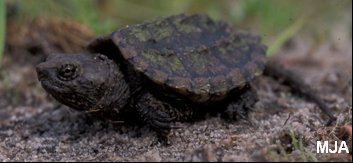
| Home | Basic Facts | Nutrition | Habitat | Reproduction | Citations | About the Author |
|---|
Found on http://www.bnl.gov/esd/wildlife/snapping_turtles.htm
Chelydra serpentina mates from the month of April to November. Adult males tend to be larger than adult females especially early in life because males tend to mature two to three years earlier than females. During copulation the male will get on top of the female and use its claws to hold on while both turtles open up their vents inside of the cloaca. Once fertilization occurs the female may store the sperm for several years. Once the eggs mature inside of the female the female will go on shore and dig a nest to lay the eggs into. The females will usually scout a spot out before digging their nest. Once the eggs are fully mature the female will lay the eggs inside of the nest and bury the eggs with sand. The average clutch size for Chelydra serpentina is any where from 20 to 40 eggs depending on the size and age of the mother. One nest was found to have on the upwards of 83 eggs in it. The eggs are amniotic eggs, meaning that all nourishment is provided by a yolk sack. Chelydra serpentina eggs are very hard and well protected. These eggs have even been said to be able to bounce if dropped on to the ground. Once the female lays the eggs she goes back into the water and that is the total extent of parental care in the common snapping turtle.
Found on http://cars.er.usgs.gov/posters/Herpetology/Snapping_Turtles/snapping_turtles.html
Once the zygote matures enough it breaks through the hard layer of egg by using a egg tooth that it provides itself. Soon after though this egg tooth disappears. Now the turtle makes the journey from the nest into the water. This is the time when the turtle is most vulnerable. It is said that the female turtles will return to the same nesting spot every year.
